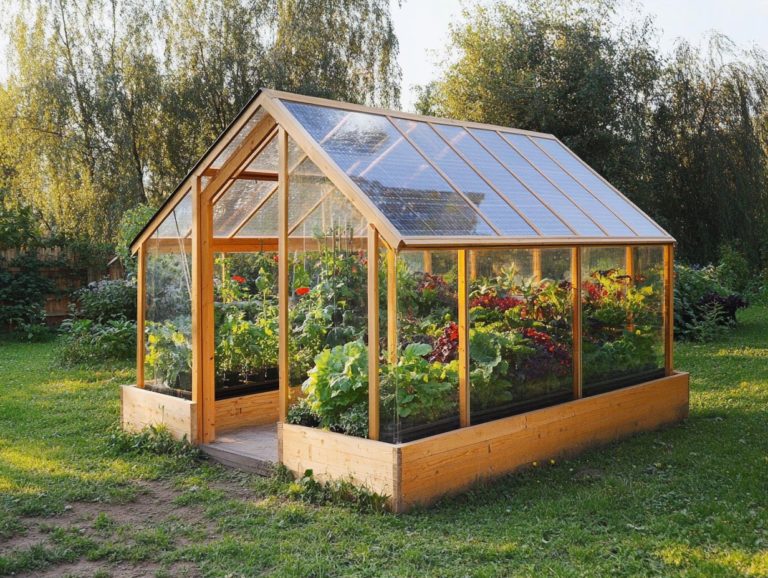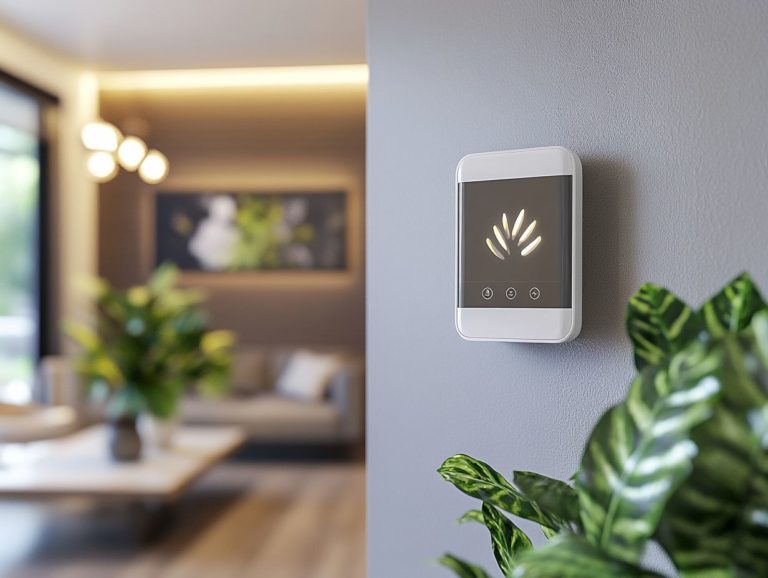DIY Energy-Saving Home Improvements
As energy costs soar, discovering ways to cut down on consumption has never been more essential not only for your finances but also for the well-being of our planet. Home upgrades that focus on energy efficiency can drastically reduce your utility bills.
By implementing energy-efficient upgrades, you can save energy and reduce costs significantly. This article delves into the significance of energy-saving home improvements, emphasizing both their environmental advantages and the financial savings they can bring. You ll find a balanced examination of the pros and cons of DIY projects versus hiring professionals, along with top-notch tips for effective DIY upgrades.
From straightforward weather stripping to the installation of smart thermostats, you’ll uncover how small adjustments can translate into substantial energy savings all while keeping your home cozy and efficient. For more detailed strategies, check out these 5 tips for energy-efficient home renovation. These home improvement measures also help in reducing utility bills and contribute to a more sustainable lifestyle.
Contents
- Key Takeaways:
- The Importance of Energy-Saving Home Improvements
- DIY vs. Professional Home Improvements
- Top DIY Energy-Saving Home Improvements
- Budget-Friendly Ways to Save Energy
- Additional Tips for Maximizing Energy Savings
- Frequently Asked Questions
- Want to save more? Check out these easy DIY energy-saving home improvements!
- How can I make my home more energy-efficient?
- Can I save money by completing energy-saving home improvements myself?
- Do energy-saving home improvements require special tools or skills? What professionals or organizations can you consult for help?
- What are some long-term benefits of DIY energy-saving home improvements?
- Are there any tax incentives for completing DIY energy-saving home improvements?
Key Takeaways:

- Energy-saving home improvements benefit both the environment and your wallet, making them a worthwhile investment.
- DIY energy-saving projects can be just as effective as hiring a professional, but it’s important to weigh the pros and cons of each approach. A check-up for your home s energy use can help you decide the best route.
- Insulation and weather stripping, energy-efficient lighting, and installing a smart thermostat are top DIY projects for saving energy at home.
The Importance of Energy-Saving Home Improvements
Energy-saving home improvements are essential for elevating both your environmental impact and your financial well-being. These upgrades can lower your utility bills. They also create a more eco-friendly living space. Companies like Elevate Energy provide essential tips for energy-efficient upgrades that you can start today.
When you install energy-efficient appliances and enhance your insulation, you’re not just conserving energy; you’re also setting yourself up for long-term savings. EnergySage provides reviews and guides on the best energy-efficient appliances. Embracing energy-efficient upgrades, like programmable thermostats and solar panels, is a savvy approach to optimizing your energy efficiency. The U.S. Energy Department recommends these installations for maximizing energy savings.
By following standards from trusted organizations like Energy Star, you ensure recognition for your efforts. Using Energy Star certified products can further enhance your home s energy efficiency.
Benefits for the Environment and Your Wallet
Imagine slashing your bills and saving the planet at the same time! Energy-efficient upgrades do just that. They offer a wealth of benefits, not just for the environment but also for your finances, as they dramatically reduce energy consumption and lower your utility bills. By conducting energy audits, you can pinpoint areas that need improvement and implement strategies that align with Energy Star standards. A Home Energy Rating System (HERS) can help assess your home’s energy performance.
The positive environmental impact is substantial; by reducing carbon footprints, you play a part in mitigating climate change while conserving essential natural resources. Experts like Bruce Sullivan from Zero Energy Project highlight the importance of these measures. When every household makes energy-efficient choices, the cumulative effect drives a shift toward sustainable power sources, fostering a cleaner ecosystem.
Beyond the ecological perks, the financial savings can be impressive. Lower utility bills free up funds for other essentials or savings, and many local and federal programs offer rebates for energy-efficient appliances, making these upgrades even more attainable. Nick Liberati from EnergySage notes that these rebates can significantly offset initial costs.
It becomes evident that investing in energy efficiency not only nurtures a healthier planet but also represents a wise financial decision. Energy-efficient lighting upgrades, such as using LED or CFL bulbs, can contribute greatly to these efforts.
DIY vs. Professional Home Improvements
When contemplating energy-saving home improvements, you may find yourself grappling with the choice between DIY projects and professional installations. Each option has its own set of advantages and drawbacks.
Opting for DIY projects can be both cost-effective and personally rewarding. You can implement energy-efficient upgrades like weatherstripping and lighting retrofits directly. For renters, exploring 5 energy efficiency solutions can also help, along with replacing old windows and doors to add to these savings.
On the other hand, professional installations provide a level of skill and reliability that is invaluable for more complex upgrades, such as HVAC (Heating, Ventilation, and Air Conditioning) system replacements or solar panel installations. Professional guidance ensures optimal performance of your heating and cooling systems.
Your choice should reflect your personal style and comfort level. Consulting resources like Emma Baumgart from Zero Energy Project will empower you to make the best choice today!
Pros and Cons of Each Approach
Every approach to home improvements whether you choose the DIY route or call in the professionals has its unique advantages and drawbacks. You should thoughtfully weigh these before diving into energy-efficient upgrades.
An energy audit evaluates your home’s energy usage and identifies improvements to make. DIY projects lead to significant cost savings and a delightful sense of personal accomplishment. However, they might not measure up to the precision and skill that professional installations deliver, especially for complex endeavors like installing solar panels or specialized HVAC systems.
Taking on DIY upgrades like weatherstripping your windows or installing low-flow showerheads allows you to tackle manageable tasks that boost energy efficiency without breaking the bank. Retrofits such as replacing incandescent bulbs with LED or CFL bulbs are also highly effective. For more ideas, check out 5 ways to improve your home’s efficiency today. These projects not only provide a gratifying sense of achievement but also contribute to a sustainable lifestyle.
Ensuring proper installation of insulation materials can further increase your energy savings. On the flip side, enlisting professional services guarantees optimal performance for complicated projects, such as retrofitting insulation or designing a green landscape, where strategic planning is key.
Professional services can also be beneficial for upgrading HVAC equipment and water heaters. They bring valuable knowledge about local regulations and compliance, often leading to enhanced energy performance and potentially increasing your property s value.
Balancing the hands-on experience of DIY with the reassurance of expert installations is essential for maximizing energy efficiency and achieving long-lasting results. Consulting with experts from the U.S. Energy Department can provide additional insights.
Top DIY Energy-Saving Home Improvements

Embarking on DIY energy-saving home improvements can yield significant energy savings without requiring professional assistance. Initial steps like an energy audit can help identify the most impactful projects. You can confidently take on projects like:
- adding insulation
- weatherstripping your doors and windows
- installing programmable thermostats
- retrofitting energy-efficient lighting
These enhancements will boost your home’s overall energy efficiency and help you cut down on those pesky utility bills. Updating your home energy rating can further validate these improvements.
Start your DIY project today and watch your energy bills drop!
Insulation and Weather Stripping
Want to boost your home s energy efficiency? Installing insulation and weather stripping is a powerful DIY project that can make a big difference! These upgrades can significantly enhance your energy efficiency and prevent heat loss.
According to experts from Elevate Energy, these improvements offer long-term benefits. By selecting the right insulation materials and properly sealing gaps around your doors and windows, you can dramatically reduce energy consumption. You ll be amazed at how much you can cut down on energy use while keeping your space cozy, ultimately leading to considerable savings over time.
For optimal results, consider materials such as fiberglass, foam board, or spray foam, which each offer unique benefits for different areas of your home. The advantages go beyond mere cost savings; they create a more comfortable living environment by maintaining consistent indoor temperatures.
You ll find various types of insulation, including fiberglass, foam board, and spray foam. Each is tailored to different areas of your home and offers unique advantages. Energy Star certified insulation can provide additional efficiencies. For example, fiberglass is perfect for attics and walls, while spray foam works wonders in those hard-to-reach nooks and crannies.
To ensure a successful installation, focus on achieving a tight fit and addressing any existing moisture issues. By meticulously applying weather stripping around drafty windows and doors, you can further enhance your home’s thermal envelope, crafting a truly energy-efficient space that you can enjoy for years to come.
Energy-Efficient Lighting
Switching to energy-efficient lighting, like LED bulbs, is a simple yet powerful way to boost your energy savings at home. By replacing traditional incandescent bulbs with LED alternatives, you can significantly cut down on energy consumption and lower your utility bills.
In fact, LED bulbs can consume up to 75% less energy than their incandescent counterparts, making them a smart investment over time. Replacing incandescent bulbs with LED or CFL bulbs can vastly improve energy savings. Compact fluorescent lamps (CFLs) and smart lighting options also present opportunities for energy savings, each boasting unique advantages.
Smart lighting systems can be integrated with programmable thermostats to enhance efficiency. For example, CFLs outshine incandescents in both lifespan and efficiency. Smart bulbs can be programmed to run only when needed, optimizing your energy use even further. Companies like EnergySage provide excellent resources for choosing the right lighting upgrades.
When selecting energy-efficient lighting, consider elements like color temperature and lumens. These aspects can greatly influence the ambiance of a room. Ceiling fans with integrated lighting can also add to energy savings. Using proper installation techniques, such as ensuring your fixtures are compatible, can amplify the benefits of these upgrades.
Smart Thermostat Installation
Installing a programmable thermostat is a smart energy-efficient upgrade that enables you to optimize your heating and cooling systems and achieve significant energy savings. Energy Star certified HVAC equipment can enhance these savings further.
By programming temperature settings to align with your schedule, you can drastically reduce energy consumption while ensuring comfort throughout your living spaces. Energy audits can help identify the best settings for your programmable thermostat.
Smart thermostats elevate this experience even further. They come with features like remote access through smartphone apps, allowing you to monitor and adjust your home s climate from virtually anywhere whether you’re at work or enjoying a getaway.
The Home Energy Rating System (HERS) can validate the effectiveness of smart thermostats in improving energy performance. These advanced devices often possess learning capabilities, adapting to your habits and preferences over time for a truly personalized experience. Incorporating these devices into your home can be a valuable part of an overall energy efficiency strategy.
In terms of home upgrades, it s essential to follow the manufacturer s instructions meticulously to guarantee compatibility with your existing heating and cooling systems. To maximize energy efficiency, regularly check for software updates and take advantage of features like geofencing, which adjusts temperatures based on your location. This enhances energy savings while ensuring that comfort remains uncompromised.
Budget-Friendly Ways to Save Energy
Saving energy is not just good for the planet; it’s also great for your wallet! Here are some budget-friendly ways to cut costs while being eco-conscious.
Saving energy need not strain your wallet; there are plenty of money-saving strategies to implement simple changes that yield significant energy savings.
You can lower your bills while making your home more energy-friendly! By concentrating on cost-effective, energy-saving home improvements and 5 ways to reduce energy waste at home, you can enjoy lower expenses while enhancing your home’s overall energy performance.
Simple Changes with Big Impact

Implementing simple changes in your home can lead to surprisingly significant energy savings and cost reductions. Small actions, such as switching to energy-efficient appliances and ensuring proper insulation materials, can collectively transform your living space into a more energy-efficient haven.
You might also consider adjusting your thermostat settings by just a few degrees. Lowering the temperature in winter and raising it in summer can significantly curb your heating and cooling costs. Using ceiling fans helps circulate air effectively, enhancing your comfort without over-relying on heating and cooling systems.
Optimizing your lighting solutions by replacing traditional bulbs with LED alternatives not only reduces energy consumption but also extends the lifespan of your lighting, ultimately saving you money on replacements and electricity costs.
When you embrace these straightforward measures, you create a more sustainable and budget-friendly living environment—one that benefits both your wallet and the planet. Consider implementing home improvement projects like the installation of solar panels and replacing windows and doors, alongside top energy-saving tips for homeowners, to further enhance energy efficiency.
Additional Tips for Maximizing Energy Savings
To truly maximize energy savings, you need to look beyond initial upgrades and embrace ongoing maintenance and additional strategies that can further elevate your energy efficiency.
Regular energy audits and a Home Energy Rating System, coupled with diligent upkeep of your energy-saving enhancements, will ensure they continue performing optimally and help you enjoy reduced utility bills over time.
Maintenance and Upkeep for Long-Term Results
Regular maintenance and upkeep of your energy-efficient upgrades are crucial for reaping long-term benefits in energy savings and cost reductions. By consistently checking your appliances, insulation, and heating and cooling systems, you can ensure that your energy-efficient improvements are operating at peak efficiency, keeping those utility bills comfortably low.
This commitment involves not just routine cleaning and servicing but also the timely replacement of filters in your heating and cooling units, which can greatly impact both air quality and energy consumption. Conducting seasonal inspections of your insulation is a smart move to prevent heat loss and gain, ensuring that energy losses are minimized.
Don t forget about your smart appliances; they come with their own set of maintenance requirements. Regularly monitoring them for software updates and performance checks will help maintain their energy-efficient functionalities. By taking proactive care of these systems, you re not only enhancing their performance but also extending their lifespan, all while contributing to a more sustainable home environment. Consider utilizing programmable thermostats to better manage your home s temperature and further reduce energy consumption.
Frequently Asked Questions
Want to save more? Check out these easy DIY energy-saving home improvements!
Some easy DIY energy-saving home improvements include installing weather stripping, using LED light bulbs, and caulking gaps in windows and doors. Additionally, replacing incandescent bulbs with CFL bulbs can lead to further energy savings.
How can I make my home more energy-efficient?

There are several ways to make your home more energy-efficient, such as adding insulation, using a programmable thermostat, and sealing air leaks. Consider upgrading to appliances approved by Energy Star for energy efficiency as well.
Can I save money by completing energy-saving home improvements myself?
Yes, completing energy-saving home improvements yourself can save you money on your energy bills in the long run, as well as on installation costs. For instance, DIY installation of solar panels can significantly reduce your energy expenses.
Start making these simple changes today and watch your energy bills drop!
Do energy-saving home improvements require special tools or skills? What professionals or organizations can you consult for help?
Some energy-saving home improvements may require special tools or skills. However, many simple improvements can be done with basic tools and knowledge. It’s helpful to get advice from experts, such as those at the U.S. Energy Department or the Zero Energy Project.
What are some long-term benefits of DIY energy-saving home improvements?
DIY energy-saving home improvements can lead to big savings! You’ll enjoy lower bills, more comfort, and a smaller carbon footprint. Regular energy audits will help you see your progress and improve efficiency.
Are there any tax incentives for completing DIY energy-saving home improvements?
Yes, you might qualify for tax incentives or rebates on certain energy-saving improvements, so it’s worth researching and keeping receipts for any materials or equipment purchased. Start your energy-saving projects today and watch your savings grow!






